Cooksonia, a very old land plant (I)
(II)
The evolution of the first land plants was a major event in the history
of Earth. It cleared the way for the irresistible development of animal life
on the land. And it was the land plants which changed the biosphere thoroughly,
e.g. the oxygen rate, the carbonic acid rate, the soil structure and the
character of the erosion.
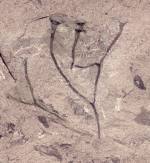  The
most famous Silurian land plant is a small creature sized up to a couple
of centimeters, named Cooksonia. It is not only the best-known plant,
but up to now also the oldest one. The
most famous Silurian land plant is a small creature sized up to a couple
of centimeters, named Cooksonia. It is not only the best-known plant,
but up to now also the oldest one.
Yet a lot is unknown about it. For example the way in which the plant was
attached to the soil.
Finding Cooksonia-fossils is difficult because only a few
occurrences are known (marine, delta of river deposits from the
Late Silurian and the earliest
Devonian). The small size of the plant is also a disadvantage for finding.
A rather complete plant is very rare.
Species
W.H. Lang published the first species of Cooksonia in 1937:
C. pertoni en C. hemisphaerica. He used Lower Devonian specimens
from Wales for his description. They were a few centimeters high, one or
more times dichotomously branched and they were bearing more or less globose
sporangia at the end of the branches. Leaves and other appendices were
absent.
He gave the genus name Cooksonia in honour of the Australian
paleobotanist Isabel Cookson with whom he co-operated in the research of
the likewise very old plant Baragwanathia from Australia.
Since then there are reports of Cooksonia-species from places
all over the world: Wales, Scotland, England, Bohemia, Kazakhstan, Siberia,
de state of New York, Canada, China, Bolivia and Brazil.
The best-known species are C. pertoni, C. hemisphaerica,
C. cambrensis, C. caledonica, all described on the basis of
British fossils. Furthermore recently the new species C. paranensis
from Brazil has been described by P. Gerrienne et al (2001).
The species are charactarized by the shape of the sporangia and the
subtending axis. Because of the variability of the form of the sporangia
identification of the species is often difficult or even impossible. The
angle with the layer in which the sporangium has been preserved is also of
great influence on the shape of the fossil. Therefore it is important for
identification to have several sporangia at one's disposal.
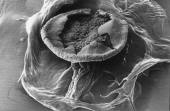 Cooksonia-sporangia did not have an special adaptation for dehiscence
at maturity. Probably the sporangium simply tore open at the upper side.
(Photo: with permission of Nature Publishing Group).
Cooksonia-sporangia did not have an special adaptation for dehiscence
at maturity. Probably the sporangium simply tore open at the upper side.
(Photo: with permission of Nature Publishing Group).

Cooksonia-species:
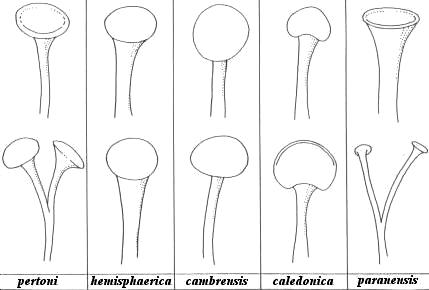
(drawing: Joep Hulst)
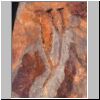 Cooksonia pertoni. The
sporangia of this plant are much broader than high. They are often so flat
that they look plate-shaped. The subtending stalk is strongly widening, whereby
the bearing part is nearly as wide as the sporangium. The sporangium is not
sunken into the axis.
Cooksonia pertoni. The
sporangia of this plant are much broader than high. They are often so flat
that they look plate-shaped. The subtending stalk is strongly widening, whereby
the bearing part is nearly as wide as the sporangium. The sporangium is not
sunken into the axis. |
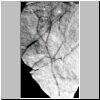 Cooksonia
hemisphaerica. The shape of the sporangia is semiglobose,
globose or elliptical. The stalk is widening below the sporangium and the
sporangium is at most about three times as wide as the top of the stalk. Cooksonia
hemisphaerica. The shape of the sporangia is semiglobose,
globose or elliptical. The stalk is widening below the sporangium and the
sporangium is at most about three times as wide as the top of the stalk.
Sporangia close to the bifurcation are mostly nicely round, while sporangia
at longer stalks are more irregularly shaped. The sporangia at short stalks
are likely to be younger. |
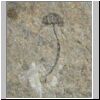 Cooksonia
cambrensis. The plant bears globose or elliptical sporangia,
sitting on stalks which are not or hardly thickening below the sporangium.
The difference with C. hemisphaerica is that the axis of C.
cambrensis is relatively much thinner immediately below the
sporangium. Cooksonia
cambrensis. The plant bears globose or elliptical sporangia,
sitting on stalks which are not or hardly thickening below the sporangium.
The difference with C. hemisphaerica is that the axis of C.
cambrensis is relatively much thinner immediately below the
sporangium. |
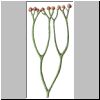 Aberlemnia
(Cooksonia) caledonica. The sporangia are variably shaped but in
most cases wider than high or even kidney-shaped. At the upper side a coaly
border can be seen in some cases. The stalk is somewhat widening below the
sporangium. Aberlemnia
(Cooksonia) caledonica. The sporangia are variably shaped but in
most cases wider than high or even kidney-shaped. At the upper side a coaly
border can be seen in some cases. The stalk is somewhat widening below the
sporangium. |
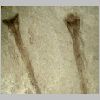 C.
paranensis. This species has been described by P. Gerrienne et al
in 2001 on the basis of hundreds of specimens from the Lower Devonian of
Brazil. The plant has a plate-shaped or bowl-shaped sporangium, that is more
or less sunken within the axis. Sporangium and stalk together are trumpet-shaped.
The sporangium does not project like that of C. pertoni. C.
paranensis. This species has been described by P. Gerrienne et al
in 2001 on the basis of hundreds of specimens from the Lower Devonian of
Brazil. The plant has a plate-shaped or bowl-shaped sporangium, that is more
or less sunken within the axis. Sporangium and stalk together are trumpet-shaped.
The sporangium does not project like that of C. pertoni. |
Cooksonia must be seen as an artificial genus. It probably consists
of several genera, which cannot be distinguished at the moment.
Continuation
Top
|